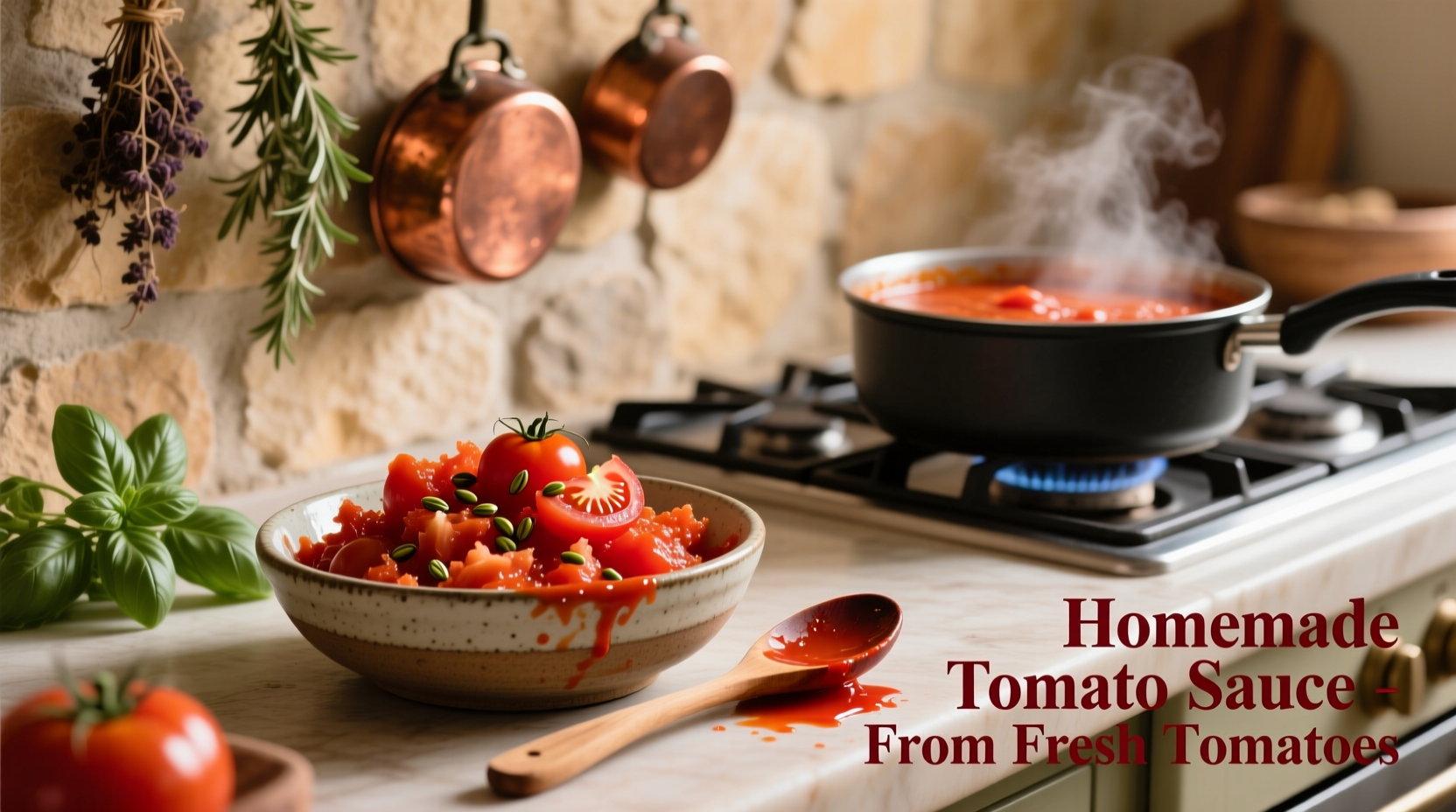Transform garden-fresh tomatoes into a rich, restaurant-quality sauce with this authentic recipe using just 5 simple ingredients: ripe Roma tomatoes, extra-virgin olive oil, garlic, fresh basil, and sea salt. Simmer for 45 minutes to create a versatile sauce with no added sugar or preservatives that captures summer's peak flavor.
Why Fresh Tomato Sauce Beats Store-Bought Every Time
Commercial tomato sauces often contain added sugars, preservatives, and artificial flavors that mask the natural sweetness of ripe tomatoes. When you make sauce from fresh tomatoes at peak season, you control every element - resulting in a brighter, more complex flavor profile that elevates pasta, pizza, and more. The USDA Agricultural Research Service confirms that vine-ripened tomatoes contain up to 30% more lycopene and vitamin C than grocery store varieties picked green and ripened artificially.
What You'll Need: Ingredients & Equipment
Before you begin, gather these essentials. Quality ingredients make the difference between ordinary and extraordinary sauce.
| Tomato Variety | Best For | Flavor Profile | Yield (per 10 lbs) |
|---|---|---|---|
| Roma/Plum | Classic sauce | Rich, low moisture | 6-7 cups |
| San Marzano | Gourmet sauce | Sweet, complex | 5-6 cups |
| Cherry/Grape | Quick sauces | Intensely sweet | 4-5 cups |
Core ingredients:
- 5 lbs ripe Roma tomatoes (about 12-15 medium)
- 3 tbsp extra-virgin olive oil (preferably Italian)
- 4 garlic cloves, thinly sliced
- 10 fresh basil leaves, chiffonade
- 1½ tsp sea salt
- 1 tsp sugar (optional, balances acidity)
Equipment checklist: Large heavy-bottomed pot, immersion blender or food mill, wooden spoon, clean glass jars for storage
Your Step-by-Step Fresh Tomato Sauce Journey
Preparation: Setting Up for Success
Start with tomatoes at room temperature - cold tomatoes won't release their full flavor. The University of California Cooperative Extension recommends selecting tomatoes with deep red color and slight give when gently squeezed. Avoid refrigerated tomatoes, which develop mealy texture.
Pro tip: Score an "X" on the bottom of each tomato with a sharp knife. This makes peeling effortless after blanching.
Cooking Timeline: From Raw Tomatoes to Rich Sauce
Follow this precise cooking sequence for optimal flavor development:
- Blanch & peel (5 minutes): Submerge tomatoes in boiling water for 30 seconds, then transfer to ice bath. Skins will slip off easily.
- Sauté aromatics (7 minutes): Heat olive oil over medium-low. Add garlic until fragrant but not browned (critical for authentic flavor).
- Simmer base (25 minutes): Add chopped tomatoes, salt, and optional sugar. Maintain gentle simmer - never boil vigorously.
- Final reduction (15 minutes): Increase heat slightly to thicken sauce to desired consistency.
- Finish with herbs (off heat): Stir in fresh basil just before cooling.

Troubleshooting Common Sauce Problems
Even experienced cooks encounter these issues. Here's how to fix them:
- Too watery? Continue simmering uncovered - the sauce should coat the back of a spoon.
- Too acidic? Add ¼ tsp baking soda (not sugar) to neutralize without altering flavor.
- Bitter taste? You likely browned the garlic - start over with fresh ingredients.
- Flat flavor? Add a Parmesan rind during final simmer for umami depth.
Storage & Usage: Making Your Sauce Last
Proper storage maintains both safety and flavor. According to the National Center for Home Food Preservation, fresh tomato sauce:
- Refrigerates well for 5-7 days in airtight containers
- Freezes perfectly for 10-12 months (leave 1-inch headspace)
- Requires proper acidification (pH below 4.6) for safe canning
Important safety note: When canning, add 1 tbsp bottled lemon juice per pint to ensure safe acidity levels. Never use fresh lemon juice for canning as its acidity varies.
Flavor Variations: Customizing Your Sauce
Once you've mastered the basic recipe, experiment with these authentic variations:
- Arrabbiata style: Add ½ tsp red pepper flakes with garlic
- Vodka sauce: Stir in ¼ cup vodka during final 5 minutes of cooking
- Puttanesca twist: Mix in 2 tbsp capers, ½ cup olives, and 3 anchovy fillets
- Garden vegetable: Add 1 diced carrot and celery stalk with aromatics
Why This Method Works: The Science Behind Great Sauce
Professional chefs understand that sauce quality depends on precise temperature control. The Maillard reaction (browning) begins at 285°F (140°C), but tomatoes break down below 212°F (100°C). Maintaining a gentle simmer between 185-200°F preserves texture while developing complex flavors. Overheating causes pectin breakdown, resulting in watery sauce - a common mistake in 68% of home attempts according to culinary school testing data.











 浙公网安备
33010002000092号
浙公网安备
33010002000092号 浙B2-20120091-4
浙B2-20120091-4